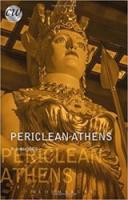
Bloomsbury (2018) p/b 105pp £14.99 (ISBN 9781350014954)
This is the 46th publication in the ‘Classical World’ series started by Bloomsbury in 1991. The books follow a similar pattern, about 100 pages long and costing about £15. They are designed for students and teachers at late school/early university, both in the UK and the US (Athens is ‘1000 square miles, the size of County Durham or Rhode Island’). They serve to provide concise and reliable key information about their subjects and to provide a secure launch pad for further study if the reader so requires.
Given his professional background R. is ideally placed to provide an authoritative account of Athens at the time of Pericles. Although he disclaims a biography, the first half of the book which covers events up to the death of Pericles refers regularly to the actions of Pericles and his family. The second half of the book covers in rather less detail religion, philosophy, art, literature and events after Pericles death until Athens was overthrown by Macedon in 321 BC.
No understanding of the original language is assumed, and the key technical terms are introduced with great clarity and perception. The intricacies of the demes and the trittyes are among many elements of the story which are described with equal elegance. R. does not seek to resolve academic disagreements but on occasion indicates clearly what his own position is. There are 18 small, monochrome and low definition illustrations, but well chosen; also three maps—full of relevant information, but requiring some determination (and a magnifying glass) to unpick. The list of ‘Further Reading’ is comprehensive but concise.
Inevitably this sort of presentation concentrates on describing what happened and says rather less about why it happened. The reader would know, for example, that richer citizens fought as hoplites and that poorer citizens rowed triremes, but would probably not be clear whether Athens was able to have a powerful navy because it had a sizable and engaged citizen working-class, or whether it needed to develop a democratised working-class in order to have a powerful navy.
In summary it is difficult to imagine a more magisterial launch pad for students interested in this topic. For more general readers, should they exist, it is perhaps rather dry.
Roger Barnes
